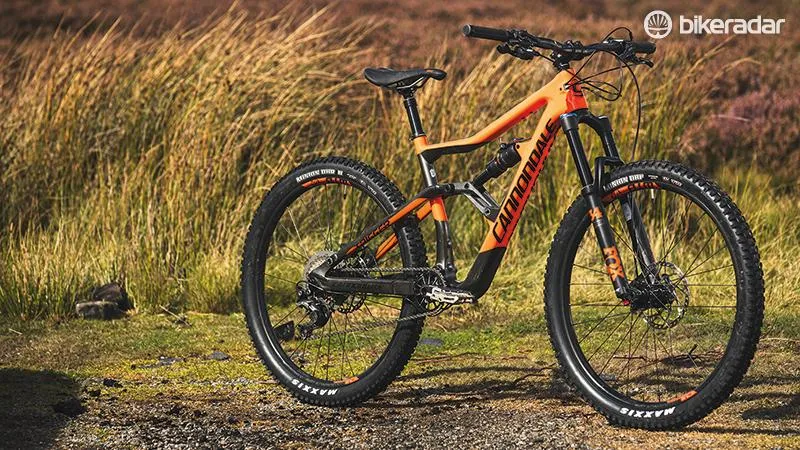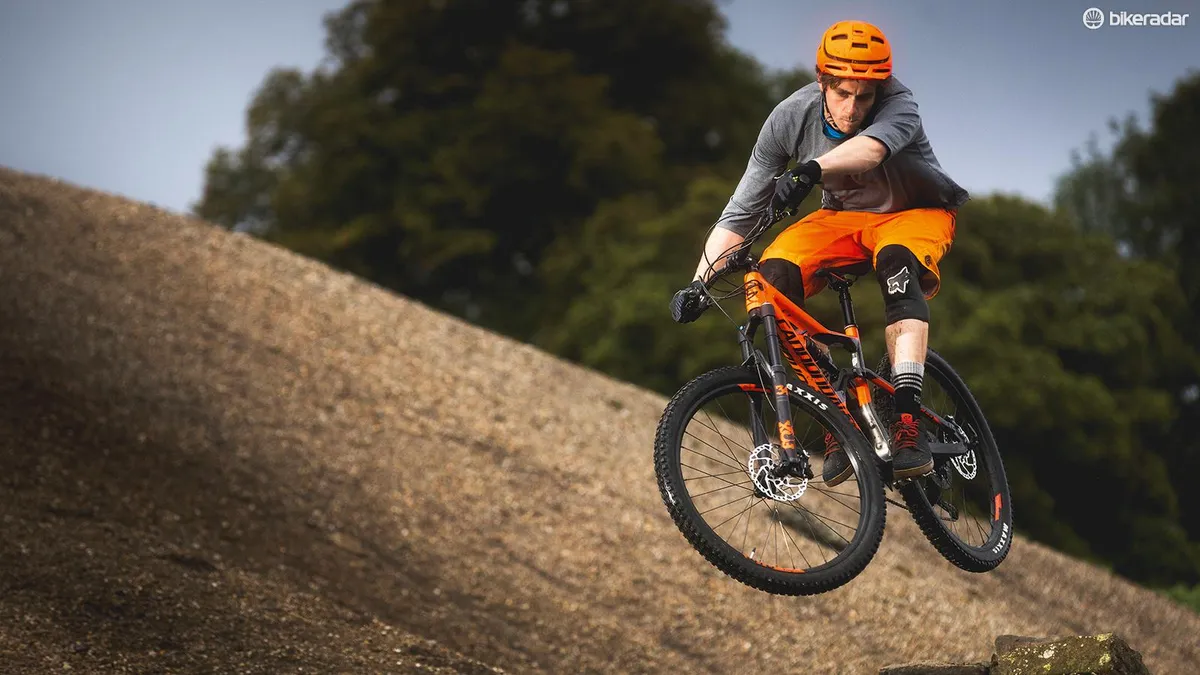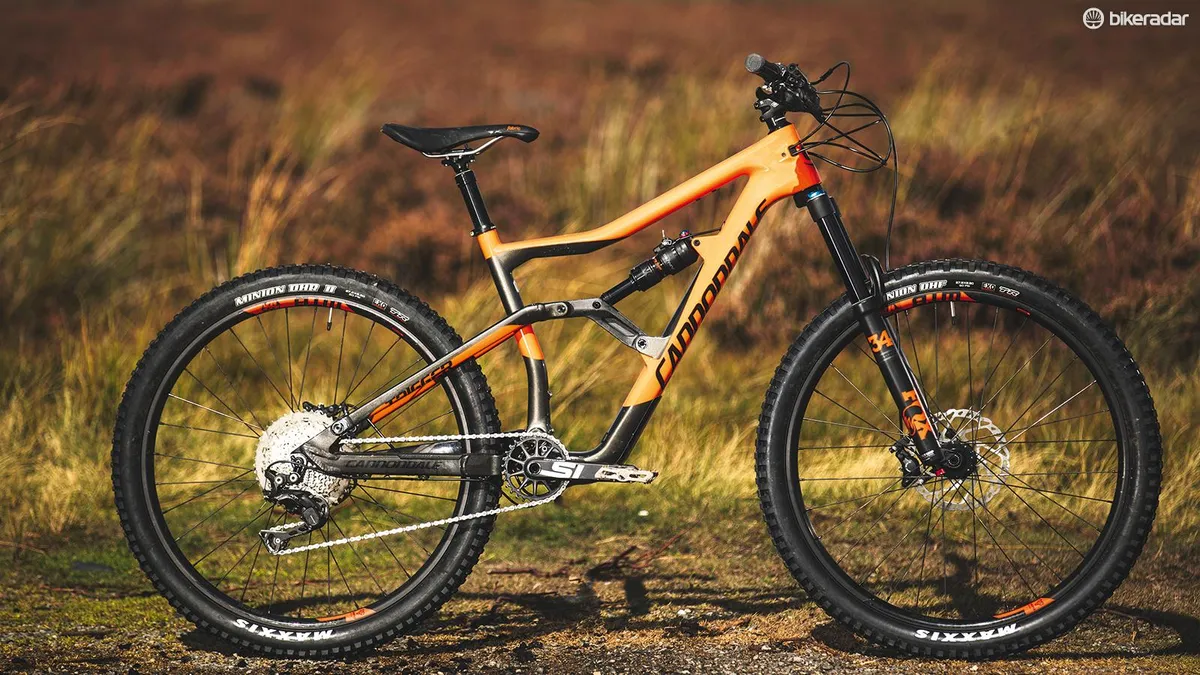Cannnodale’s Trigger trail bike is a distinctive, well-shaped, feature-loaded all-rounder, but it needs careful tuning to get the best from it.
The Cannnodale Trigger looks similar to the Jekyll enduro bike but the head tube ‘box’ is shorter and the tube shapes of the ‘BallisTec’ carbon mainframe are subtly different too.
Because the mid-frame carbon linkage now drives a conventional shock, there’s room for a bottle where the old Trigger’s pull shock used to be. It also means you get a modified Fox Float X damper, not a totally proprietary design as before.
Cannondale co-invented the 30mm axle standard so there’s no surprise the Trigger has a PF30 bottom bracket (BB). It also uses its ‘Ai’ offset stays and a 148mm hub to keep things tight out back.
Cannondale Trigger 3 kit

The Fox ‘Gemini’ shock is matched with a Fox 34 fork, which is near the top end of its travel range at 150mm. While 29mm WTB rims bulk up the 2.35in Maxxis tyres to 57mm wide, they also square off the carcass for a slower, less supple roll, and the whole wheel pack is relatively heavy.
Overall bike weight is fairly hefty too, though the 30t ring fitted to Cannondale’s SpideRing cranks help offset this.
Shimano’s XT/SLX transmission clicks dutifully through most gears but the 37t to 46t gap at the top of the cassette makes keeping a consistent cadence hard. The SLX brakes had a random bite point issue on one side too — a common problem.
They sit on a wide bar (with matching 45mm stem), while you sit on a nice Fabric saddle atop a TransX dropper that’s essentially the same as the Race Face post on the Santa Cruz and the JD on the Saracen.
Cannondale Trigger 3 ride impressions

With its 14kg weight, long reach, big bar, broad rims with grippy tyres and the slackest head angle on test, you’d expect the Trigger to feel rock solid and connected on the trail. The Fox fork and shock are ‘Performance’ units with a tight and tappy, rather than soft and grippy, initial feel.
This reluctance to get moving combines with the tall BB and centre of gravity to perch the bike on top of the trail rather than hunker it down. I had to drop tyre pressures lower than usual to stick the Trigger to the floor predictably over roots and rocks.
The Trigger does carry speed well once things get steep and sizeable but stay straight
Setting shock pressure proved a test of patience too. Even with two volume spacers and 200psi+ (for a 70kg rider), it regularly slammed to full travel, even in the firmer compression settings that left it feeling uptight under power.
That also meant very little mid-stroke cornering support in 145mm-travel ‘Flow’ mode, so if I knew a descent was bermy rather than bouldery, I’d flick to the 115mm ‘Hustle’ setting to give me a firmer feel to carve with. This left the Trigger short on big-hit capability, so adding extra spacers would make more sense.
The extended legs of the 34 fork (which is only adequately stiff at best) and its tall ride height, added to the tappy initial suspension feel and relatively flexy front end, make the Trigger feel hesitant and short of confidence through turns for a 14kg bike with a great front tyre. That weight and the grippy rubber mean it’s the steadiest here in terms of powered speed too, with even the 2.6in-tyred Specialized feeling faster on the pedals in stuttery sections.
On the upside, the Trigger does carry speed well once things get steep and sizeable but stay straight. The ‘FIT GRIP’ damper in the fork works really well deeper in its stroke, and the slacker head angle and long reach make it stable at speed, as long as you don’t have to turn. If you drop your heels and let it run, the linear back end swallows square edges impressively too.
Unfortunately for the Trigger, the Jekyll has even more big-hit appetite, a significantly stiffer fork and front end, and a better balance between its 165mm ‘Flow’ and 130mm ‘Hustle’ modes. Even with 2.5in and 2.4in tyres (which feel better suited to the same i29 rims), the same-priced Jekyll 3 is only 300g heavier too.

